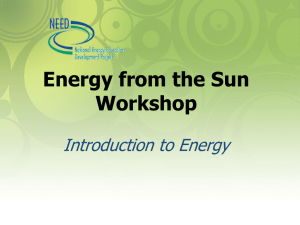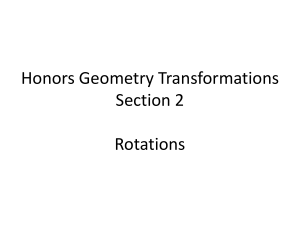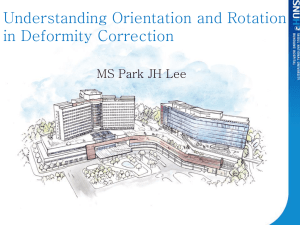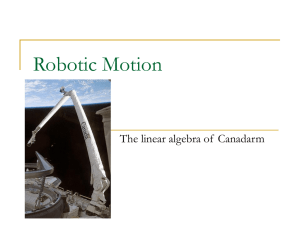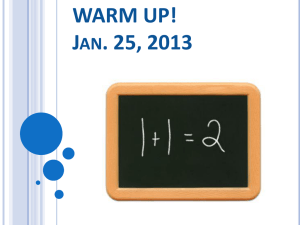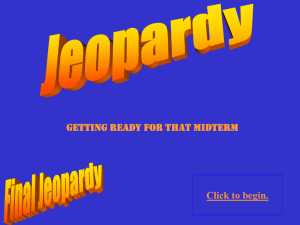Presentation
advertisement
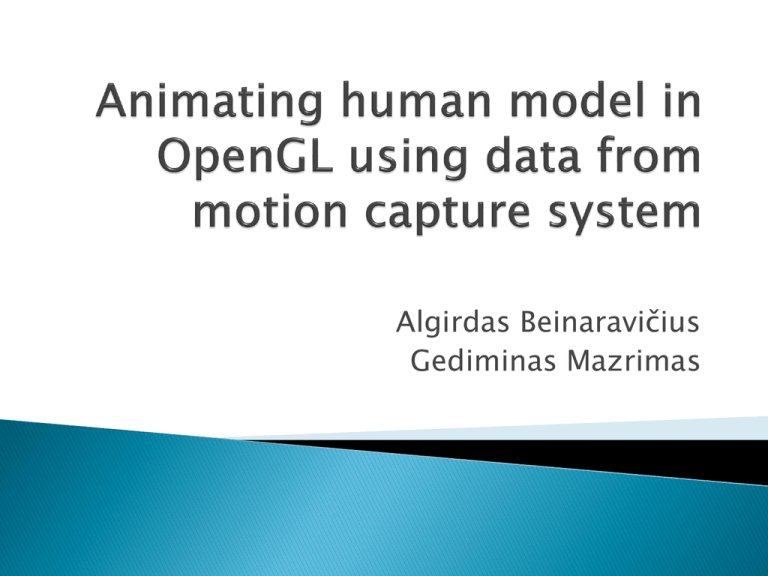
Algirdas Beinaravičius
Gediminas Mazrimas
Introduction
Motion capture and motion data
Used techniques
Animating human body
Problems
Conclusion and future work
Motion capturing
Human body model animation
◦
◦
◦
◦
Animation program environment (C++/OpenGL)
Data interpretation
Skeleton and its motion
Model mesh (skin) and its deformations
Motion capture
◦ What is Mocap? Where it is used?
Various motion capture systems
◦ Optical, Magnetic, Mechanical, Inertial
Motion capture using Vicon Motion System
◦ Basic Vicon MX system model
+ Suit with retroreflective markers
Various motion data formats
◦ C3D, ASF/AMC, BVH, FBX
Used formats
◦ Default C3D format for Vicon Motion System
Binary format, saves 3D coordinates
◦ BVH format. Getting from C3D to BVH
Saves hierarchy (skeleton joint structure) and
transformation data
HIERARCHY
ROOT Hips
{
OFFSET 0 34.322 0
CHANNELS 6 Xposition Yposition Zposition Zrotation Xrotation Yrotation
JOINT LeftHip
{
OFFSET 4.587 -1.043 0
CHANNELS 3 Zrotation Xrotation Yrotation
JOINT LeftKnee
{
OFFSET 3.09 -15.571 0
CHANNELS 3 Zrotation Xrotation Yrotation
JOINT LeftAnkle
{
OFFSET 2.179 -16.111 -2.139
CHANNELS 3 Zrotation Xrotation Yrotation
JOINT LeftAnkle_End
{
OFFSET 0 -0.867 1.597
CHANNELS 3 Zrotation Xrotation Yrotation
End Site
{
OFFSET 1 0 0
}
}
}
}
}
JOINT RightHip
{
...
}
...
}
Frames: 1289
Frame Time: 0.033333
19.8598 80.309 -11.521 -0.661911 0.799904 171.213 -1.85002 2.52617
10.7515 3.17067 -1.01583e-010 -10.2854 -1.58501 -1.94847 -0.0287346 0 0
0 -0.0555542 2.6936 -11.4833 -0.562183 1.22223e-006 11.8361 0.284375 1.65435 -0.00579677 0 0 0 -1.25693 6.24787 -0.51793 3.27727 -16.0419 1.36162 14.6579 0.0301162 -3.60178 -5.21488 6.12318 -3.03665 2.47876
0.000451064 -6.17142e-006 -0.509607 -8.47663 0.248473 0 0 0 -15.7988
1.60936 -7.32667 1.93902 -8.80292 5.13737 -1.30308 7.39538e-009
8.53796e-007 0.267783 -4.03835 0.26339 0 0 0 0.258752 -0.0812672
0.831621 12.5445 1.71161 -2.09692 0 0 0
19.8771 80.2868 -11.5326 -0.700186 0.756134 171.114 -1.84667 2.51303
10.794 3.13528 -1.01593e-010 -10.2526 -1.58653 -1.95993 -0.0287348 0 0 0
-0.0627105 2.65564 -11.4946 -0.56617 1.2219e-006 11.9114 0.31303 1.66464 -0.0057968 0 0 0 -1.29175 6.15499 -0.450865 3.47648 -15.6579 1.30103 14.4269 0.0330917 -3.62714 -5.39613 6.06833 -2.95956 2.27028
0.000451064 -6.17142e-006 -0.527485 -7.40878 0.0488122 0 0 0 -15.6207
1.62543 -7.46368 1.75456 -9.10966 5.12076 -1.08476 7.39538e-009
8.53796e-007 0.274961 -4.00089 0.215719 0 0 0 0.444407 -0.387448 0.74024
12.1183 2.50324 -2.11188 0 0 0
…
Parametric representation of lines in 3D space
Linear blend skinning
Quaternions
Forward kinematics
Line segment connects separate mesh body
parts
Each vertex on the segment is influenced by
our LBS algorithm
Parametric representation of the line:
◦ L(t) = A + b * t
A – starting point, b = B – A vector, t - parameter
A and B could be taken as two
points on two separate meshes.
By scaling t – proportional
vertex positioning along the
line is achieved.
Skin deformations
◦ Anatomy (layer) based deformations
◦ Direct skin deformation
Linear blend skinning and its different
implementations
Artifacts of the algorithm
Before animation:
•Mesh model and skeleton in T-pose
•Mesh vertices assigned influencing joints with weights
Replace three separate (Z, Y, X) rotations with
a single rotation.
Solve the gimbal lock problem.
Four scalars.
q=a+i*b+j*c+k*d
a – real dimension
i * b, j * c, k * d – imaginary dimensions
•
•
•
•
•
•
•
i * i = j * j = k * k = -1
i*j=k
j * i = -k
j*k=i
k * j = -i
k*i=j
i*k=j
(a + i∗b + j∗c + k∗d) ∗ (e + i∗f + j∗g + k∗h) =
(a ∗e - b∗f - c∗g - d∗h) + i∗(a∗f + b∗e + c∗h - d∗g) + j∗(a∗g- b ∗h + e∗c + d∗f) +
k∗(a∗h + b∗g - c∗f + e∗d)
Quaternion multiplication represents a
rotation.
◦
◦
◦
◦
q1 – representation of rotation around X axis
q2 – representation of rotation around Y axis
q3 – representation of rotation around Z axis
q = q1 * q2 * q3 – representation of rotation
around Z Y X axes.
q = a + i * b + j * c + k *d
◦
◦
◦
◦
a = cos(angle / 2)
b = axisX * sin(angle / 2)
c = axisY * sin(angle / 2)
d = axisZ * sin(angle / 2)
◦
◦
◦
◦
◦
angle = arccos(a) * 2
sinA = sqrt(1 – a*a)
vectorX = b/sinA
vectorY = c/sinA
vectorZ = d/sinA
Rotation ends up with unsuspected results
Axes of rotations lock together
Technique, used to position body parts in 3D
scene
◦ Each joint has its local transformation
◦ Global transformation of each joint depends on it’s
parent transformation
From a mathematical point of view:
Mnglobal = Πni=0Milocal
n – current joint in the hierarchy
Geometry definition file format
Open ASCII format
Supported by many 3D modelling applications
v -0.756447 0.702621 0.047024
vt 0.487840 0.942165 0.000000
vn 0.149280 -0.186998 -0.240511
f 6/9/6 2/5/2 1/1/1
Continuous body
mesh model was cut
in separate body
parts.
Vertices on the lines
connecting these
parts are influenced
on deformation.
T-pose is required
Every vertex on the connecting line is
assigned a weight (by its position on the line)
◦
Rotation angle for each vertex:
◦ RotA = A*w,
P=1..N
A – joint rotation angle
Our final LBS formula:
◦
Initial BVH pose
Exploding knee problem
Mesh connections collapsing on complex
deformations
Initial pose was I-pose, while we needed Tpose:
◦ Caused problems while connecting separate mesh
body parts and associating vertices with joints.
◦ Noticed only BVH file import into our program
(most of the 3rd party application programs starts at
frame 1).
Solution:
◦ Joint offsets in hierarchical skeleton structure had
to be changed. After that all rotations also had to
be recalculated.
Appeared:
◦ Overall rotation calculated as 3 separate around Z,
Y and X axes.
◦ “Gimbal lock” caused faulty vertices positions on
LBS algorithm.
Solution:
◦ Use of quaternions and additional filter for rotation
angle.
Primary tests of our Linear Blend Skinning
algorithm (rotation only around 1 axis)
Algorithm results with rotations around all 3
axes.
Possible solutions for current algorithm:
◦ Defining different weight values for vertices
◦ Cutting mesh body parts differently (cutting out
less)
Main project tasks achieved, though various
improvements are possible:
◦ More detailed body animation and skin
deformations
◦ Integrate facial animation
◦ Skinning algorithm improvement
◦ Live streaming from mocap system
?


